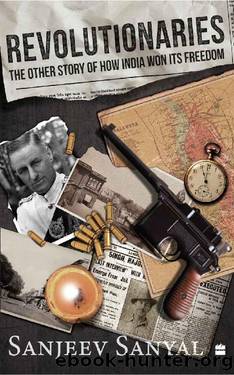Revolutionaries by Sanjeev Sanyal

Author:Sanjeev Sanyal [Sanyal, Sanjeev]
Language: eng
Format: epub
Tags: null
Publisher: HarperCollins India
Published: 2023-01-09T16:00:00+00:00
THE KAKORI TRAIN ROBBERY
Ram Prasad Bismil was born in 1897 into a poor family in a village in Shahjahanpur, the United Provinces. According to Bismilâs autobiography, written on death row, his grandfather had migrated from the Chambal area to Shahjahanpur during a severe famine.15 The family barely survived on subsistence wages. By the time he was born, however, circumstances had somewhat improved, as his father had managed to create a small business selling official stamps in the local court. By his own admission, Bismil was an energetic but unruly child, who regularly got into trouble. However, in his mid-teens, he turned to religion and started to conduct the evening rituals at the village temple. He was also influenced by the ideals of the Arya Samaj and a charismatic preacher, Swami Somdev, who strongly advocated nationalist ideas. (As an aside, the swami had also influenced Raja Mahendra Pratap.) It was under these influences that Bismil became an enthusiastic organizer in his district of âshuddhiâ, or purification programmes (i.e., reconversion to Hinduism).
The young Bismilâs initiation into political life was through the nationalist faction of the Congress. At a party meeting in Lucknow, he organized a small group of volunteers to give Tilak a grand reception, despite the opposition from the Loyalist faction. This earned him the ire of the rival group. It was also in Lucknow that he first came in contact with the revolutionaries and soon got involved. Over the next year, he produced a number of underground pamphlets and posters in support of the freedom struggle; they were all banned by the colonial authorities. In due course, he started to explore ways to acquire small arms. His tract on this issue is quite illuminating about the difficulty faced by revolutionaries operating in central India to procure guns:
Many people have the misconception that in the rural hinterlands, everyone carries a gun and no license is needed. One would presume, therefore, that such weapons were in easy circulation. While to some extent, it is indeed true that no license is required and everyone is free to keep a gun; still it is mandatory to keep the local police informed every time a bullet or explosive is procured. It is not like you walk into shops in open market and buy bullets and cartridges. Imported explosives or sealed cartridges have to be brought in from outside the princely states, which requires a permit from the Resident Officer (Government representative who is deputed to the princely state). To circumvent such a cumbersome procedure, shotguns are manufactured within the state, indigenous explosives are also produced by mixing Sulphur and coal. Even with a hypothetical freedom to keep the weapons, each village would have barely a person or two of affluent status or the rich landlord class who could afford to keep shotguns which they use with locally made bullets. The storage of the explosive charge too was difficult as they would go stale in the humidity and thus become useless beyond one season.16
Like many other
Download
This site does not store any files on its server. We only index and link to content provided by other sites. Please contact the content providers to delete copyright contents if any and email us, we'll remove relevant links or contents immediately.
| Chakras | Gandhi |
| History | Rituals & Practice |
| Sacred Writings | Sutras |
| Theology |
Fingersmith by Sarah Waters(2019)
Kundalini by Gopi Krishna(1829)
The Bhagavad Gita by Bibek Debroy(1668)
Indian Mythology by Devdutt Pattanaik(1626)
Wheels of Life by Anodea Judith(1616)
The Yoga of Jesus: Understanding the Hidden Teachings of the Gospels by Paramahansa Yogananda(1534)
The Man from the Egg by Sudha Murty(1503)
Autobiography of a Yogi (Complete Edition) by Yogananda Paramahansa(1492)
Chakra Mantra Magick by Kadmon Baal(1388)
The Book of Secrets: 112 Meditations to Discover the Mystery Within by Osho(1359)
Avatar of Night by Tal Brooke(1258)
The Sparsholt Affair by Alan Hollinghurst(1248)
Karma-Yoga and Bhakti-Yoga by Swami Vivekananda(1234)
Sparks of Divinity by B. K. S. Iyengar(1231)
The Bhagavad Gita (Classics of Indian Spirituality) by Eknath Easwaran(1209)
Gandhi by Ramachandra Guha(1199)
The Spiritual Teaching of Ramana Maharshi by Ramana Maharshi(1175)
Skanda Purana (Great Epics of India: Puranas Book 13) by Bibek Debroy & Dipavali Debroy(1140)
Hinduism: A Very Short Introduction (Very Short Introductions) by Knott Kim(1123)
